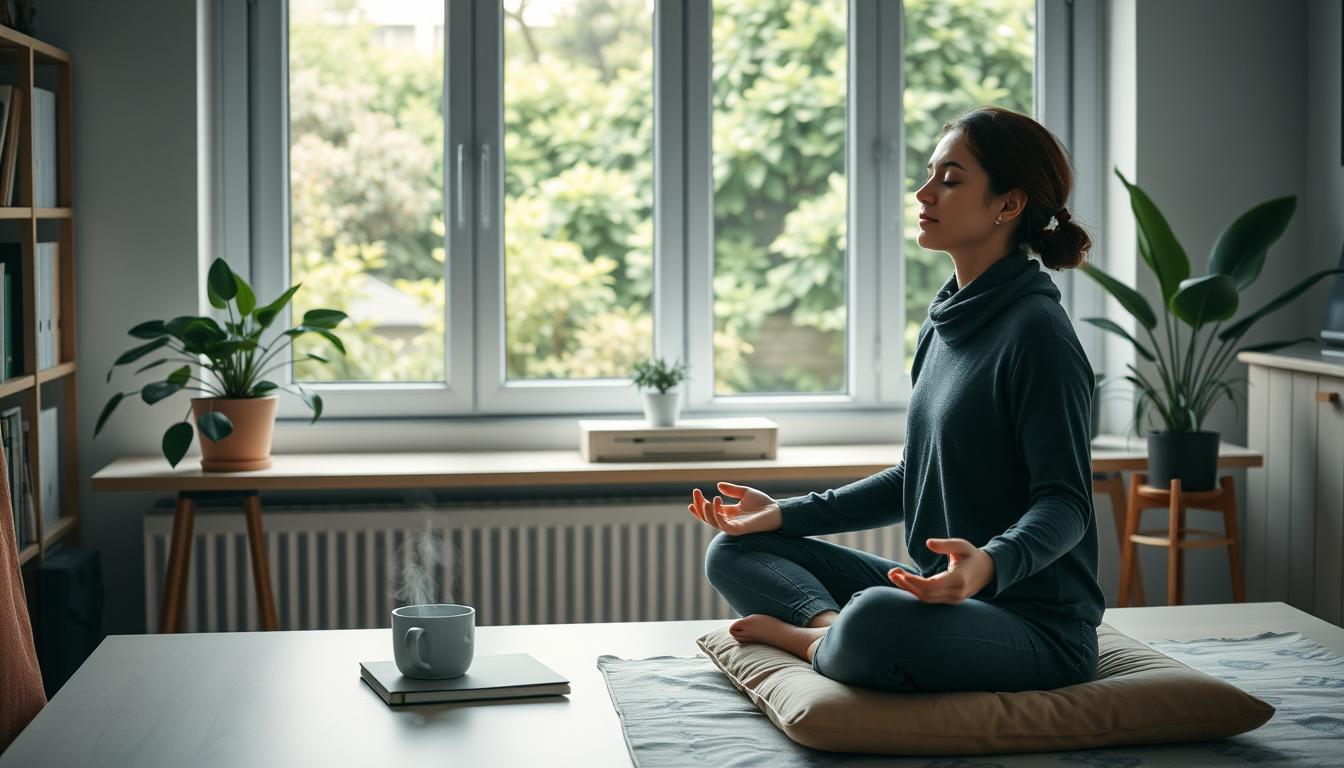In today’s fast-paced world, maintaining mental well-being can be a challenge, especially when faced with hectic schedules and demanding lifestyles. Did you know that approximately 1 in 5 adults in the United States experiences mental illness each year?
This staggering statistic highlights the importance of finding simple, effective ways to prioritize mental health even on the busiest of days. Incorporating minute mental health habits into daily routines can make a significant difference in overall well-being.
Key Takeaways
- Simple habits can significantly improve mental health.
- Incorporating mental health habits into daily routines is crucial.
- Even brief moments of mindfulness can be beneficial.
- Busy schedules don’t have to compromise mental well-being.
- Small changes can lead to significant improvements.
The Power of Minute Mental Health Habits in Modern Life
With the pressures of contemporary life, incorporating minute mental health habits can significantly enhance mental wellness. In a world where time is scarce, these brief practices offer a feasible way to prioritize self-care. By integrating short, effective techniques into daily routines, individuals can better manage stress and improve their overall mental health.
Why Small Habits Make a Big Difference
Small habits, when practiced consistently, can lead to significant improvements in mental well-being. They help in building resilience and provide a sense of control over one’s mental health. Mental wellness tips often emphasize the importance of starting small, making it easier to incorporate new habits into a busy schedule.

The Science Behind Micro-Interventions for Mental Wellness
Micro-interventions are grounded in the science of how brief, targeted practices can positively impact mental health. Research supports the idea that even short moments of mindfulness or deep breathing can reduce stress and enhance mood, contributing to overall self-care.
Quick Breathing Techniques to Reset Your Mind
Reset your mind with simple, effective breathing techniques that can be done anywhere, anytime. These quick exercises are designed to help you manage stress and improve mental clarity.
Box Breathing for Instant Calm
Box breathing is a powerful technique that involves breathing in for a count of 4, holding for a count of 4, exhaling for a count of 4, and holding again for a count of 4. This creates a “box” shape with your breath.
How to Perform Box Breathing in 60 Seconds
To practice box breathing, start by sitting comfortably with your back straight. Close your eyes and begin by inhaling for 4 seconds, filling your lungs completely. Hold your breath for 4 seconds, then exhale slowly for 4 seconds. Finally, hold your breath again for 4 seconds. Repeat this cycle for 60 seconds.
4-7-8 Breathing Method
The 4-7-8 breathing method, also known as the “Relaxation Breath,” involves breathing in through your nose for a count of 4, holding your breath for a count of 7, and exhaling through your mouth for a count of 8. This technique can help slow down your heart rate and promote relaxation.
When to Use These Techniques During Your Day
These breathing techniques can be used at various times during the day to help manage stress and improve focus. Try using them during your morning routine, before a meeting, or during a short break at work.
| Technique | Benefits | When to Use |
|---|---|---|
| Box Breathing | Instant calm, improved focus | Before a meeting, during breaks |
| 4-7-8 Breathing | Promotes relaxation, slows heart rate | Before bed, during stressful moments |
60-Second Mindfulness Practices
Brief moments of mindfulness can have a profound impact on your day, providing a much-needed pause. Incorporating mindfulness practices into your daily routine can be simple and effective, even in just a minute.
The Mindful Minute Meditation
The Mindful Minute Meditation is a straightforward yet powerful practice. It involves focusing on your breath, observing your thoughts without judgment, and grounding yourself in the present moment. This meditation can help reduce stress and improve mental clarity.
Sensory Awareness Exercises
Sensory awareness exercises engage your senses to bring you into the present. One such exercise is the 5-4-3-2-1 Grounding Technique.
The 5-4-3-2-1 Grounding Technique
- Notice 5 things you can see around you.
- Acknowledge 4 things you can touch or feel.
- Identify 3 things you can hear.
- Recognize 2 things you can smell.
- Take 1 deep breath, focusing on the sensation.
Integrating Mindfulness into Daily Activities
Mindfulness isn’t limited to dedicated meditation sessions. You can integrate mindfulness into daily activities like eating, walking, or even doing the dishes. Paying attention to the sensations, sights, and sounds can turn mundane tasks into mindfulness practices.
Desk-Friendly Physical Movements for Mental Clarity
For those with demanding schedules, integrating short physical movements at your desk can be a game-changer for mental clarity. These movements help reduce the physical and mental strain of prolonged sitting, enhancing overall well-being.
Quick Stretches to Release Tension
Simple stretches can alleviate the tension built up from sitting for long periods. Try neck rolls, shoulder shrugs, and wrist extensions to loosen tight muscles.
Micro-Exercises to Boost Mood and Energy
Micro-exercises, such as chair squats or desk push-ups, can increase blood flow and oxygenation to the brain, boosting mood and energy levels.
Creating Movement Triggers in Your Environment
Setting reminders or placing post-it notes as cues can encourage regular movement. For example, you can do a set of stretches every time you save a document or take a phone call.
| Movement | Benefit | Trigger |
|---|---|---|
| Neck Rolls | Reduces Neck Tension | Every hour |
| Chair Squats | Boosts Energy | Before a meeting |
| Wrist Extensions | Relieves Wrist Strain | After typing for 30 minutes |
Minute Mental Health Habits for Busy Days: Creating a Personalized Toolkit
To effectively incorporate minute mental health habits into daily life, creating a tailored approach is essential. This involves understanding your specific mental health needs and crafting a set of strategies that work best for you.
Assessing Your Specific Mental Health Needs
Begin by identifying the sources and types of stress you encounter daily. Reflecting on your emotional responses and physical sensations can help you pinpoint areas where minute mental health habits can be most beneficial.
Matching Habits to Different Types of Stress
Different stressors may require different interventions. For instance, breathing techniques might be more effective for anxiety, while physical movements could be better suited for stress related to prolonged sitting or physical tension.
Building Your Custom One-Minute Intervention Plan
Once you’ve identified your needs and matched habits to your stress types, it’s time to create a plan. Consider the following sample schedule:
Sample One-Minute Mental Health Schedules
| Time of Day | Habit | Benefit |
|---|---|---|
| Morning | Quick Breathing Exercise | Sets a calm tone for the day |
| Midday | Desk Stretch | Reduces physical tension |
| Afternoon | Mindful Minute Meditation | Improves focus and clarity |
By creating a personalized toolkit and incorporating these habits into your daily routine, you can better manage stress and enhance your overall mental well-being.
Implementing Habits Throughout Your Busy Day
Effective stress management is within reach, even on the most hectic days, with the right mindfulness practices. By incorporating minute mental health habits into your daily routine, you can significantly improve your overall well-being.
Morning Minute Habits to Start Strong
Begin with a morning meditation or a quick journaling session to set a positive tone for the day. This helps in clarifying your thoughts and prioritizing tasks.
Midday Reset Practices
Use deep breathing exercises or a short walk to reset your mind during the midday slump. These practices help in reducing accumulated stress and improving focus.
Evening Wind-Down Techniques
Engage in progressive muscle relaxation or a gratitude journal to unwind in the evening. This aids in transitioning to a restful state, preparing your body for sleep.
Transition Moments as Habit Opportunities
Identify transition moments in your day, such as during your commute or before meetings, as opportunities to practice mindfulness. Even a few seconds of focused breathing can be beneficial.
| Time of Day | Habit | Benefit |
|---|---|---|
| Morning | Meditation or Journaling | Sets a positive tone, clarifies thoughts |
| Midday | Deep Breathing or Short Walk | Reduces stress, improves focus |
| Evening | Progressive Muscle Relaxation or Gratitude Journal | Aids in unwinding, prepares for sleep |
Overcoming Barriers to Minute Mental Health Practices
Despite the benefits of minute mental health practices, many individuals face barriers to implementing them consistently. One of the primary obstacles is the perception that these practices are too time-consuming or that one is too busy.
Addressing the “Too Busy” Mindset
The first step in overcoming the “too busy” mindset is to reframe one’s perception of time. Mental wellness tips often emphasize that even brief moments can be beneficial. For instance, taking a few deep breaths during a short break can be a valuable mental health practice.
Setting Reminders and Creating Cues
To incorporate quick self-care routines into daily life, setting reminders or creating cues can be effective. This might involve setting an alarm on your phone or placing a sticky note in a visible location.
Building Consistency Through Habit Stacking
Habit stacking involves attaching a new habit to an existing one. For example, if you always drink coffee at a certain time, you could stack a minute meditation practice onto this existing habit.
| Barrier | Solution |
|---|---|
| “Too Busy” Mindset | Reframe perception of time, emphasize brief moments |
| Lack of Reminders | Set alarms, create visual cues |
| Inconsistent Practice | Habit stacking, attach new habits to existing ones |
Transforming Your Mental Health One Minute at a Time
By incorporating minute mental health habits into your daily routine, you can significantly improve your overall well-being. The strategies discussed, including quick breathing techniques, 60-second mindfulness practices, and desk-friendly physical movements, provide a comprehensive toolkit for managing stress and promoting relaxation.
Busy day mental health strategies, such as these, can be seamlessly integrated into your daily life, allowing you to reset and recharge throughout the day. By leveraging relaxation techniques, you can better navigate the challenges of modern life and cultivate a more balanced mental state.
Start your journey today by selecting the practices that resonate with you the most and begin to transform your mental health one minute at a time. With consistency and patience, you can develop the habits necessary to support long-term mental wellness.
